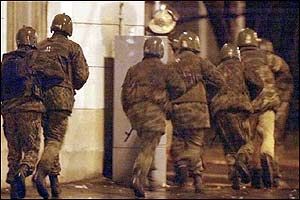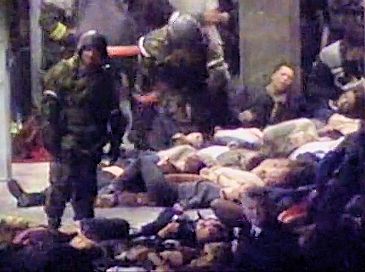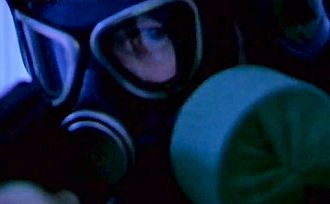![]()
Fentanyl
The knock-out gas controversially used
to end the Moscow theatre siege.
![]()
Paul May
Bristol University, UK
![]()
Molecule of the Month March 2015
Also available: JSMol version.
![]()

|
FentanylThe knock-out gas controversially used
|
 |
No, it was more recent, 2002 in fact, when a group of 40 armed terrorists from the Chechen Republic took 850 people hostage in a theatre in Moscow, and demanded an end to the ongoing war in Chechnya. They placed explosives around the theatre which they threatened to detonate killing everyone inside if the authorities tried to end the siege by force.

Still from a video taken from the theatre's CCTV cameras, showing the hostages sitting
in their seats and two armed terrorists standing at the side.
The siege continued for 2 and a half days, but when the terrorists started executing the hostages the Russian authorities were forced to act. Russian Special Forces (Spetsnaz) pumped a knock-out gas into the theatre in order to pacify or incapacitate the terrorists, and then raided the theatre, killing all 40 of the terrorists.
Well, although the siege was ended, the knock-out gas was so powerful that about 130 of the hostages died from asphyxiation as well. The use of the gas was condemned by a number of governments around the world, but both the US and UK governments said it was justifiable given the desperate situation and lack of any better alternatives.

Still from a video taken outside the theatre,
showing the rescued hostages, many of them still
unconscious and awaiting treatment by the paramedics.
That was the question everyone asked at the time. Initially, the Russians would not disclose the identity of the gas, claiming it was a military secret. This had the unfortunate effect that paramedics treating the asphyxiated patients did not know how to counteract its effects, and it is believed many hostages died as a result of this unnecessary secrecy. Because many of the affected hostages had stopped breathing, the paramedics tried treating them with naloxone (Narcan) - a drug which reverses the depression of the respiratory system and which is usually used to treat opiate drug overdoses. This seemed to work on some of the hostages, leading people to suggest that the knock-out gas had been some sort of opioid.
 And was it?
And was it?We still donít know for sure, because the Russian authorities have never officially disclosed what the gas was. But forensic examination of the bodies and clothes of those that had died led investigators to suggest that the gas was Kolokol-1, an aerosol version of 3-methylfentanyl.
Itís a derivative of fentanyl, which is well known to doctors as a powerful painkiller and anaesthetic. As a painkiller, fentanyl is about 80-100 times more potent than morphine and several times more potent than heroin. It has been used since the 1960s as a general anaesthetic, but also as a general painkiller in the form of analgesic patches or even 'lollipops' (see image below). Itís also used as a veterinary sedative for small animals. However, the drug has the unfortunate side-effect that depresses the respiratory system, so if too much is given the patient stops breathing.
|
|
That doesnít sound very safe.Used with medical supervision it is perfectly fine. But, as with all medicines, there have been a small number of cases where patients died from accidental medical overdoses. A bigger problem is that because of its similarity in effect to heroin and morphine, fentanyl has also been used illegally as a recreational drug, which has led to several fatal overdoses. For example, in 2010, Paul Gray (photo, right), the bassist of the heavy-metal band Slipknot overdosed and died after using a mixture of fentanyl and morphine. The rock-star Prince also died in early 2016, and an autopsy concluded it was due to an accidental self-administered overdose of fentanyl. Such overdoses are not uncommon - in March 2016 the number of fatal fentanyl overdoses in New Orleans became so large it exceeded the homocide rate! |
|
Chemists made a number of derivatives of fentanyl to change its potency. These included:
SufentanilAdding a sulphur created a compound that was ~5-10 times more potent than fentanyl. It is often used as a painkiller and mostly administered intravenously or via an epidural. This is the most potent fentanyl derivative that is used in humans. |
AlfentanilAdding a side-group at the alpha position (hence the name) created a drug that has 1/4 to 1/10 the potency of fentanyl and around 1/3 of its duration of action. Because of its fast onset and offset, it is used as a painkiller in surgical operations. |
RemifentanilThis analogue is about twice as powerful fentanyl, but because of the ester linkage in its side-chain, it is metabolised rapidly giving it a short half-life of around 4 mins in the body. It is used for painkilling during surgery or for general anaesthetic. It is also given as a sedative to patients undergoing electroconvulsive therapy. |
CarfentanilThis is one of the most potent opioids known, and is the most potent opioid used commercially, with a potency ~100 times that of fentanyl. It is too powerful for use in humans, but is used as a general anaesthetic for large animals, such as bison or elephants. |
α-methylfentanyl
|
Well, because it is relatively easy to manufacture compared to the other analogues, 3MF as it was known, became popular in the mid-1980s as a street drug. However, its extreme potency (10-15 times as potent as fentanyl, and ~1000-6000 times as strong as morphine) made it very dangerous and resulted in many deaths, usually as a result of serious respiratory failure.
Itís believed so, yes. They had secretly weaponised 3MF by dissolving it in halothane, which can then be sprayed as an aerosol vapour or pumped into a building. Within a few minutes the inhabitants of the building fall unconscious, but because the dosage is uncontrolled some unconscious victims stop breathing completely and die unless treated urgently, as happened in Moscow. However, some experts believe there's more to it than that, as such a potent gas should have caused far more casulaties than the 20% that occurred in Moscow. In fact, if 3-methylfentanyl or another of the fentanyl analogues were used in isolation, some experts were surprised that there were any survivors at all. So another possibility is that fentanyl or one of its more potent derivatives were mixed with an unknown secret stimulant which had the ability to revive the victim's respiratory functions without waking them up. But until the Russians finally come clean, we may never be absolutely certain what was in the gas.
![]()
![]()
![]() Back to Molecule of the Month page. [DOI:10.6084/m9.figshare.5259745]
Back to Molecule of the Month page. [DOI:10.6084/m9.figshare.5259745]